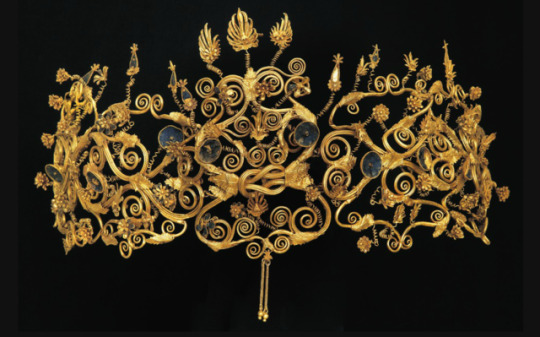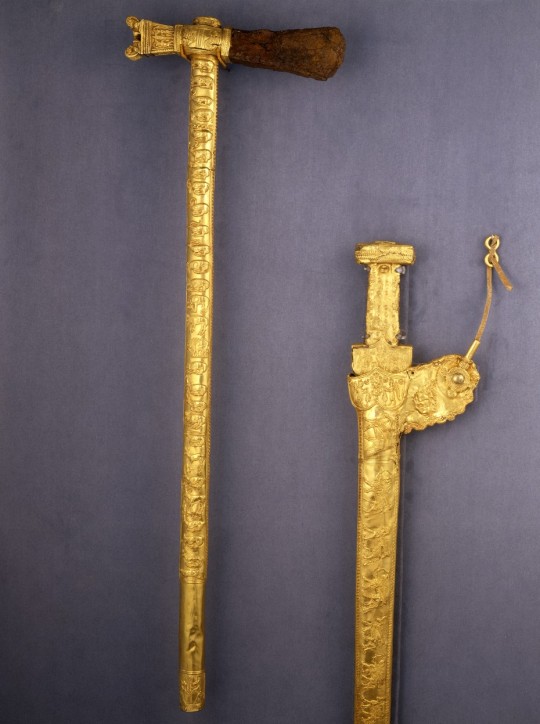Don't wanna be here? Send us removal request.
Photo

Scythian gold ring dating to the 4th century BCE.
143 notes
·
View notes
Photo

Scythian gold and garnet necklace, no date given.
31 notes
·
View notes
Photo


~ Gold Torque Terminating in Scythian Horsemen. Place of origin: The Northern Black Sea Region Date: 4th century B.C. Place of finding: Crimea, the environs of Kerch, the Kerch Peninsula Archaeological site: Kul Oba Barrow Medium: Gold, enamel
#reblog#scythia#scythian jewelry#scythian jewellery#scythian torcs#scythian necklaces#torcs#torques#necklaces#4th century BCE#gold#crimea#crimean jewelry#crimean jewellery#crimean necklaces#crimean torcs
3K notes
·
View notes
Photo



Scythian gold torque in the form of dragons, dated to the 2nd century BCE to the 1st century CE. From the source:
Hundreds of tiny scales are individually soldered to the writhing forms of two confronted dragons on this magnificent gold torc. Thick curving horns sweep back over the long pointed ears of the rather wolf-like dragon heads. With muzzles drawn into ferocious snarls, these mighty beasts express the formidable strength of the Scythians, one of ancient Eurasia’s most powerful cultures.
#scythia#scythian jewelry#scythian jewellery#scythian torques#scythian necklaces#dragons#gold#2nd century bce#1st century BCE#1st century ce
4K notes
·
View notes
Photo

Scythian gold torque, dating to the 4th century BCE. No source given, image found on Pinterest.
#scythian jewelry#scythian jewellery#scythia#scythian torques#scythian necklaces#necklaces#torques#gold#4th century BCE
652 notes
·
View notes
Photo

The golden diadem of the Scythian princess Meda, found in the tomb of Philip II of Macedon. Aigai, Macedonia, Greece. 4th century BC [960x700]
#reblog#i think meda was a thracian princess#thrace#thracian jewelry#thracian jewellery#thracian diadems#ancient greece#Ancient Greek Jewelry#ancient greek jewellery#ancient greek diadems#Macedon#philip II of macedon#meda of odessos#ancient macedonian jewelry#ancient macedonian jewellery#ancient macedonian diadems#diadems#gold#4th century BCE
11K notes
·
View notes
Photo

i was half drawing Queen Tomyris but she came out way more Turkic than Iranian so w/e somebody Central Asian I guess
27 notes
·
View notes
Photo


First posters for Akan Satayev’s Tomyris
135 notes
·
View notes
Photo

imma disappear to play more civ6 now
167 notes
·
View notes
Photo

Scythian axe and sword; gold, c. 5th century BC
606 notes
·
View notes
Photo

Gold Scythian ornament in the shape of a stag, dating to the 7th-6th centuries B.C.E.
#scythian jewelry#scythian jewellery#scythia#stags#gold#7th century bce#6th century bce#scythian ornaments#ornaments
112 notes
·
View notes
Photo

~ Dress ornament. Date: ca. 5th century B.C. Geography: Northern Black Sea region, possibly from Maikop Culture: Scythian Medium: Gold
486 notes
·
View notes
Photo

An arm from the throne of a Scythian king, 7th century BC.
Found at the Kerkesmess Barrow in Krasnodar Krai, exhibited in the Hermitage Museum.
726 notes
·
View notes
Photo


Tomyris by Veysel Kara
Tomyris (/ˈtoʊmɪrɪs/; from Eastern Iranian: Tahmirih “Brave”) also called Thomyris, Tomris, Tomiride, or Queen Tomiri, was a Massagetean ruler who reigned over the Massagetae, an Iranian people from Scythian pastoral-nomadic confederation of Central Asia east of the Caspian Sea, in parts of modern-day Turkmenistan, Afghanistan, western Uzbekistan, and southern Kazakhstan.
#history#scythian#antiquities#ancient#5th century bc#ancient history#ancient weapons#deer#gold#griffin
1K notes
·
View notes
Photo

Roundel with griffin heads
Eurasian steppes, Sarmatian (ca. 1st–2nd century)
Medium: Silver, gilding, inlays
From the Metropolitan Museum of Art
359 notes
·
View notes
Photo

Gold belt plaque: Scythians with horses under a tree
Siberia, 4th–3rd century BC
From The State Hermitage Museum
583 notes
·
View notes